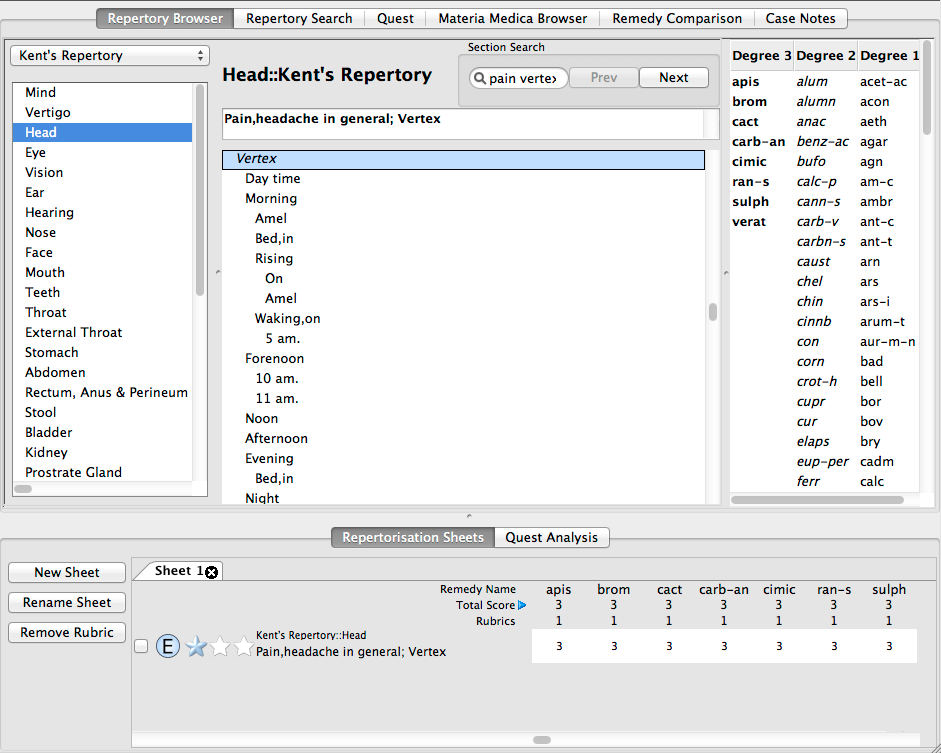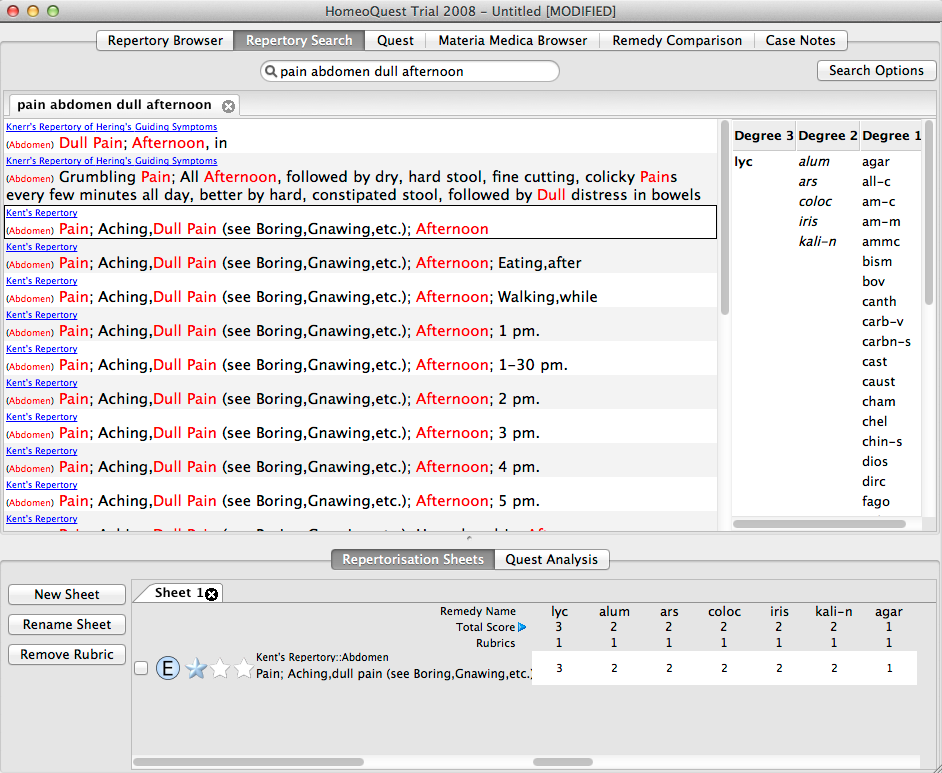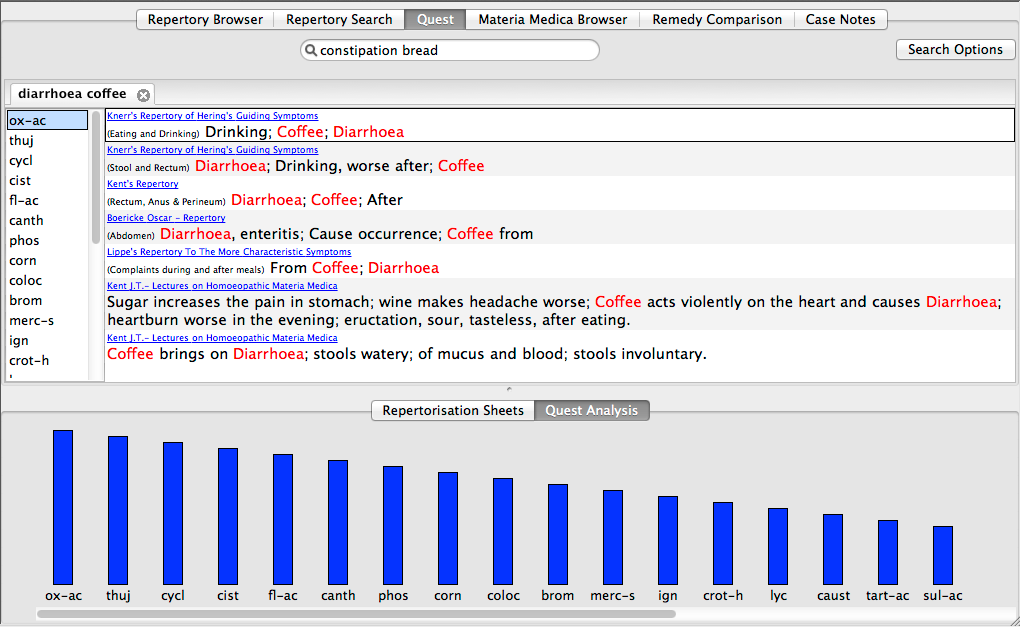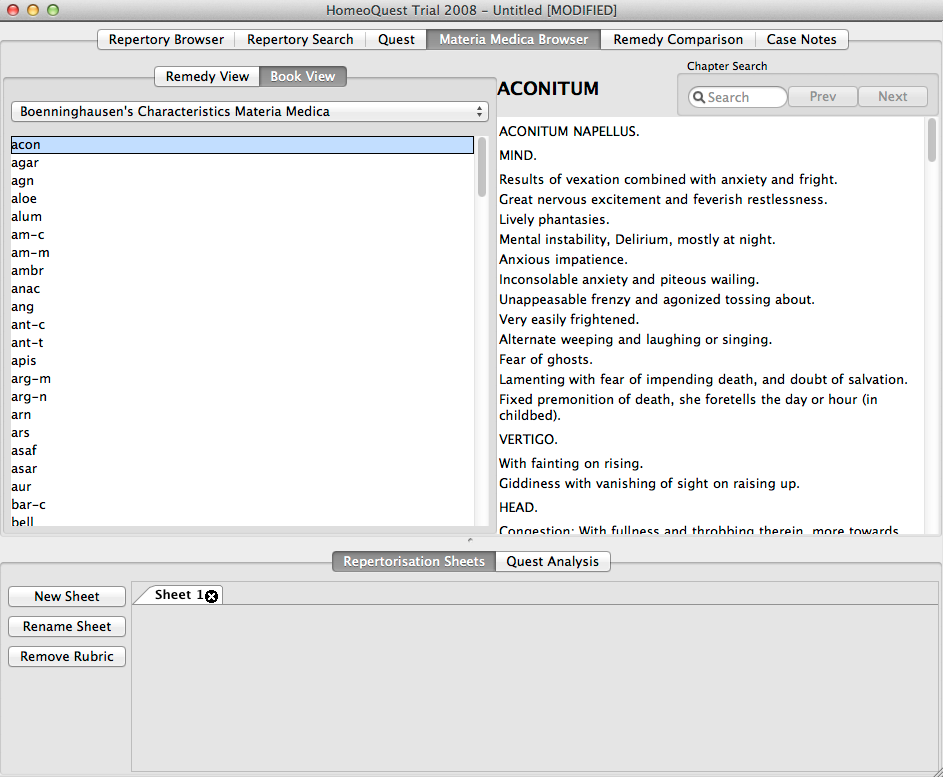Homeoquest Review
HomeoQuest Software Review
Introduction
Let's look at the software in some detail. (You might like to download the free "community" version before you continue, so that you can check features as we discuss them.
The library.
At the core of HomeoQuest is its library of repertories and materia medica. There are eight repertories and twelve materia medica (a detailed list can be found at the end of this review). One of the benefits for students is the ability to use this library as a study resource, reading the material directly from the program or - in the case of materia medica - extracting sections for study via a simple copy and paste procedure. HomeoQuest has six separate sections:
- Repertory Browser
- Repertory Search
- Quest
- Materia Medica Browser
- Remedy Comparison
- Case Notes
Let's look at each in turn.
The Repertory Browser
In the browser, you first choose a repertory to study. The list of sections appears in the box at left. Clicking on a section brings up the full list of rubrics in the main window. You can scroll through the rubrics to find the one you want, or simply enter some words in the search box at the top. HomeoQuest will then take you to the first instance of the words entered. NEXT and PREVIOUS buttons allow you to jump quickly through the section, checking all instances of your search criteria. When you find the rubric you want, you simply double-click on it. The rubric is added to the repertorisation sheet at the bottom of the program window, and the recommended remedies are displayed. As you continue your search, adding more rubrics from the same or different repertories, HomeoQuest analyses the total group of selected rubrics on the fly, and updates the hierarchy of recommended remedies instantly. When you have entered all rubrics relevant to the case, you have the completed analysis in front of you. If there is no clear "winner" in the hierarchy of remedies, you can continue the analysis by clicking on each of the contending remedies, which will take you to the materia medica for further study, or add them to the REMEDY COMPARISON section of HomeoQuest to undertake a detailed comparison. The Repertory browser is the ideal place to start if you like to search through individual repertories, rather than all repertories in combination.

In this screen shot, Kent’s Repertory has been selected, the “Head” section is highlighted. The words “pain vertex” have been entered into the search window. The rubric “Pain,headache in general; Vertex” has been chosen, and the results appear in the the Repertorisation sheet at the bottom of the screen.
The Repertory Search.
Opening the Repertory Search presents you with a simple search box. To begin your search, you type in a word or words in the box. As you type, HomeoQuest presents you with a list of choices related to the word you are typing. Since these choices relate directly to known rubrics, they allow you to focus in quickly on the right expression of the symptom you are researching. You can alter the focus of your search, making it narrower or broader, by selecting from the "Search Options" list at the top right of the window. The "Advanced Options" section of this feature allows you to select an individual repertory, a group of repertories, or all of the repertories as the focus of your search. Having entered your search criteria, clicking on the Search Icon will instantly bring up all of the instances of the chosen rubric from all of the selected repertories in the main window. You can then scroll through these to select appropriate references. Clicking on a reference takes you to the repertory browser, where the full detail of the reference can be checked. When you are happy that the reference is the one you want, double clicking on the rubric will add it to the repertorisation sheet, as before. You can then return to the Repertory Search to repeat the process for other symptoms. As you proceed, HomeoQuest carries out your analysis efficiently in the background, presenting you with a hierarchy of remedies from which to choose when the process is complete.

In this screen shot, the words "pain abdomen dull afternoon" have been searched. All of the rubrics in the chosen repertories containing those words are shown in the main part of the window. The remedy hierarchy for the highlighted rubric is shown at right
Quest
This is by far my favourite feature of HomeoQuest. It allows you to search quickly for a symptom through the entire database of repertories and materia medica at the same time. It presents its results in a graphical representation of the remedy hierarchy, rather than a list of numbers, and this for me is a preferred method. As for the Repertory Search, you begin with a simple search box. The "Search Options" button now allows you to choose precisely those repertories and materia medica you wish to include in the search, or to search the entire library. As you enter your search criteria, you are again given choices as to appropriate words. Clicking the Search Icon (or clicking "return") brings up all the references to the chosen rubric in both repertories and materia medica. Clicking on a reference takes you to the correct listing in the materia medica, for further reading, or to the repertory for selection of the correct rubric for analysis, and inclusion in the repertorisation sheet.

In this screen shot, the words "diarrhoea coffee" have been searched. The hierarchy of significant remedies is shown at left, and a graphical representation of the hierarchy is shown at the bottom of the screen. Ox-ac has been highlighted, and the main window shows the relevant rubrics for this remedy.
As you go through this process, you are provided with two constantly updated remedy hierarchies: the repertorisation sheet, and the Quest graphical hierarchy. The interesting point here is that these two hierarchies are not necessarily identical. Quest and Repertory Search use slightly different algorithms to arrive at their results. For me, this is an exciting feature. It allows you to compare the results of each algorithm and choose the most appropriate for the case. In most cases, however, I found the Quest analysis to provide the best solution. Entering some cured case examples to test the feature, I found Quest produced the correct remedy either at the top, or close to the top, of the hierarchy in almost every case. This would give me the confidence to use Quest in a live patient interview, entering symptoms on the fly and coming up with a quick result. As Shilpa Bhouraskar promises, Quest takes about ten minutes to analyse a case. I don't know of any other software that can so quickly complete an analysis, and I've tested many of them.
Materia Medica Browser
The Materia Medica Browser can be used in several different ways. There are two basic views: Book View and Remedy View.
Book View has a drop-down menu which allows you to choose the Materia Medica you want to access. When you have chosen, a list of all the remedies in that particular work are listed in the index window below. Clicking on a remedy brings up the relevant chapter in the main window.

This screen shot shows Book View. Boenninghausen's Repertory has been selected, and the remedy Aconite highlighted. The Relevant chapter is shown in the main part of the window.
Remedy View has a drop-down list of remedies. After choosing a remedy, all the Materia Medica works containing that remedy are listed in the index window below. Clicking on a Materia Medica brings up the relevant chapter in the main window.

Remedy View is shown in this screen shot. The remedy Aconite has been chosen from the drop-down menu, and Clarke's Materia Medica highlighted. The relevant chapter from the work is shown in the main part of the window.
When you have made a selection in one of the above ways, you can then search the material in the main window by entering words into the search window at the top right of the program. This will highlight every instance of the search criteria in the main window. Previous and Next buttons allow you to jump through these instances quickly to find the one you want.
Remedy Comparison
The potential of this feature of HomeoQuest is so huge, and its functions so numerous, that I will not attempt a detailed review here. It enables in-depth analysis of individual remedies, as well as detailed, subtle analysis of relationships between remedies. It is the ideal place to go when you have two or more closely qualified remedies from which to choose. There are four distinct comparison modes: Combined, Common, Contrast and Unique.
- Combined mode displays all of the rubrics of the selected remedy or remedies. With search criteria added, it displays the rubrics in the search criteria, wherever they appear in the remedies analysed.
- Common Mode displays only the rubrics which are common to all of the remedies being analysed. With search criteria added, it displays only the rubrics which appear in all of the remedies being analysed, filtered by the search criteria.
- Contrast Mode shows rubrics which contain only one of the remedies being analysed.
- Unique Mode shows all rubrics which appear in only one of the remedies.
Search criteria can be modified in multiple ways, which makes this one of the most versatile features of the software.

In this screen shot three remedies, Arsenicum, Lycopodium and Nux vomica are being compared. The word "constipation" is in the filter box, and the comparison format is "Common". The main window shows all the "constipation" rubrics which appear in all three remedies
Case Notes
This section is a simple note-pad where you may enter notes in the course of an interview. Its advantage is that you can do this from within the software, rather than having to move between different programs, or between computer and patient card. When finished with note-taking, it is a simple matter to copy and paste the notes into a more comprehensive patient record database.
Summary
I really like this software. It doesn’t try to be all things to all homeopaths. It doesn’t claim to include every reference to every remedy in the entire history of homeopathy (as some other software programs do). It does a reliable case analysis quickly and efficiently, using the most commonly employed Materia Medica and Repertories. In other words, it does what a homeopath without a software program would do, using works that every homeopath should have, but does it in a fraction of the time, and without any of the fuss and bother.
Other points in favour of HomeoQuest:
- It isn't expensive, and there are several payment options
- It is extremely simple to use
- The entire process can be completed in a single window
- There are versions for MAC and PC
- A comprehensive series of easy-to-follow tutorials is provided
- The "Community" version of the software is free to download
But don't take my word for it. Download the free version, and try it out for yourself.
Download HomeoQuest Free Version
The list of source materials
Repertories
- Roger van Zandvoort's Complete Repertory 20121
- Roger van Zandvoort's Complete Repertory Basic2
- Kent's Repertory
- Boenninghausen's Repertory (by Boger C.M.)
- Boericke Oscar - Repertory
- C.M. Boger's Repertory
- J.H. Clarke's Clinical Repertory
- Knerr's Repertory of Hering's Guiding Symptoms
- Lippe's Repertory To The More Characteristic Symptoms
- Roberts' Sensation As If
1Avaliable only with HomeoQuest Gold 2Avaliable only with HomeoQuest Silver
Materia Medicae
- Allen T.F - Encyclopedia of Pure Materia Medica, vols.1-10
- Hering C.- The Guiding symptoms of our materia medica, vols.1-10
- Clarke J.H.- Dictionary of Practical Materia Medica, vols. 1-3
- Kent J.T.- Lectures on Homoeopathic Materia Medica
- Boenninghausen's Characteristics Materia Medica
- Boericke W.- Materia medica
- Boger C.M. - Synoptic Key
- Lippe A. Von - Keynotes of Homeopathic Materia Medica
- Allen H.C.- Keynotes and Characteristics
- Nash E.B.- Leaders in Hom. therapeutics
- Allen H.C.- Therapeutics of Fever
- Hahnemann S.- Chronic Diseases, theory and practice, vols.1-2
